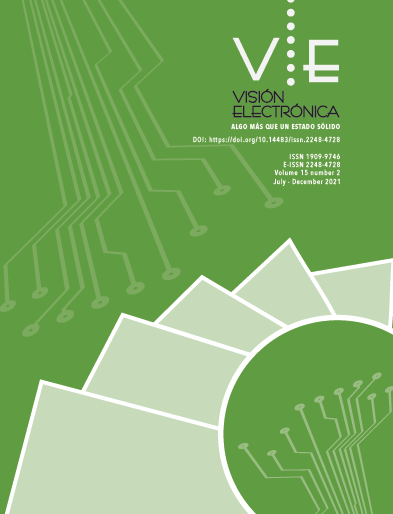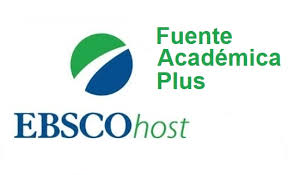Publicado:
2023-04-21Número:
Vol. 17 Núm. 1 (2023)Sección:
Visión InvestigadoraDesign of a resistor using Geometric Modeling to be included in a virtual laboratory and develop a DC circuit practice
Diseño de un resistor a través del Modelamiento Geométrico para incorporarse en un laboratorio virtual y desarrollar una práctica de circuitos DC
Palabras clave:
3D, Blueprint programming, Electronic, Resistive circuits, Resistor (en).Palabras clave:
3D, Circuitos resistivos, Electrónica, Laboratorio virtual, Programación blueprints, Resistor (es).Descargas
Resumen (en)
This document presents the results of the research framed in the project named Design of a Virtual Laboratory to the Circuits Analysis and Instrumentation, using Geometric Modelling, where a basic element as the resistor is proposed to the development of exercises improving the basic skills in circuit analysis, according to the background about virtual laboratories usage in engineering education. Also, this research got the characterization of basic resistive elements to subsequently begin with complex designs as photoresistors whose behavior is similar. In this exercise some resources were used as well as Autodesk Maya to the physical structure of the element, and Unreal Engine to define the element’s interaction into the laboratory. The methodology of the design fits into the stablished one in project to define the mathematical equation that describe its behavior in similar conditions as reality and its virtualization to be included in virtual laboratory to finally end up with the validation of performance. As a result, the construction of a resistive device that represents the behavior as in reality was developed, and its satisfactorily incorporated into the virtual laboratory.
Resumen (es)
Este documento presenta los resultados de la investigación enmarcada en el proyecto denominado Diseño de un Laboratorio Virtual para la Práctica de Análisis de Circuitos e Instrumentación, por medio de Modelamiento Geométrico, donde se propone un elemento básico como el resistor para el desarrollo de prácticas que fortalezcan la apropiación de competencias básicas en análisis de circuitos, teniendo en cuenta los antecedentes del uso de laboratorios virtuales para la formación en ingeniería. Con esta investigación se logra la caracterización de los elementos resistivos básicos para posteriormente pasar a diseños más complejos. Para este ejercicio se utilizaron diferentes herramientas como Autodesk Maya para el diseño de la estructura física del elemento, y Unreal Engine para definir las interacciones del elemento en el laboratorio. La metodología de diseño se ajusta a la establecida en el proyecto para definir la ecuación matemática del comportamiento del elemento que represente su funcionalidad en similares condiciones a las reales y su posterior virtualización para incluirse en el laboratorio virtual para finalmente terminar con la validación de funcionamiento. Como resultado se logra la construcción de un dispositivo resistivo que representa el comportamiento en la realidad y que se incorpora satisfactoriamente en el laboratorio virtual.
Referencias
J. Buitrago-Molina, J. Carvajal-Guerrero, y C. Zapata-Castillo, “Plataforma virtual para el mando local y remoto de un brazo robótico de apoyo para la educación en ingeniería”, Tecno Lógicas, vol. 17, núm. 32, 2014.
N. J. Rodriguez García y I. C. Nieto Sánchez, “Consideraciones para el diseño de un sistema diagnóstico de frenos de disco en un vehículo particular”, Avances, vol. 14, p. 76, 2017, doi: 10.18041/1794-4953/avances.1.1286.
K. Takemata, A. Minamide, S. Nakamura, y N. Tanba, “Design of lifelong learning content using space education - Development of the mobile 3D (three dimensional) image projection system”, en Proceedings of the 2011 11th IEEE International Conference on Advanced Learning Technologies, ICALT 2011, 2011, pp. 197–198, doi: 10.1109/ICALT.2011.63.
W. Ridgewell, V. Kumar, O. Lin, y Kinshuk, “OpenSim virtual worlds as platform for enhanced learning concepts”, en Proceedings of the 2011 11th IEEE International Conference on Advanced Learning Technologies, ICALT 2011, 2011, pp. 623–624, doi: 10.1109/ICALT.2011.192.
H. N. Wu, X. M. Wang, L. K. Yu, T. Yuan, y S. G. Kuai, “Rendering a virtual light source to seem like a realistic light source in an electronic display: A critical band of luminance gradients for the perception of self-luminosity”, Displays, vol. 59, pp. 44–52, sep. 2019, doi: 10.1016/j.displa.2019.07.001.
J. Zhang, “Implementation and Optimization of Particle Effects based on Unreal Engine 4”, en Journal of Physics: Conference Series, 2020, vol. 1575, núm. 1, doi: 10.1088/1742-6596/1575/1/012187.
F. R. L. Viscaino y J. P. Sebastá, “LabView, entorno gráfico de programacióm”, Comput. Sci., p. 4, 2007 [Online]. Disponible en: https://www.semanticscholar.org/paper/LabView%2C-entorno-gráfico-de-programacióm-Vizcaíno-Sebastiá/bea05b9eb695a894760865bda606f0bdc64890ba#related-papers
A. A. A. A. and R. L. T. CÁCERES, “Study of kinetic formation and the electrochemical behavior of polypyrrole films”, J. Chil. Chem. Soc, 2009, doi: 10.4067/S0717-97072009000100004.
Á. Arrieta A. y R. L. Tarazona C., “Sistema multicanal con instrumentación virtual para una lengua electrónica”, Ingeniare, vol. 22, núm. 3, pp. 338–350, 2014, doi: 10.4067/S0718-33052014000300005.
F. Salimi y F. Salimi, A Systems Approach to Managing the Complexities of Process Industries - 1st Edition. 2017 [Online]. Disponible en: https://www.elsevier.com/books/a-systems-approach-to-managing-the-complexities-of-process-industries/salimi/978-0-12-804213-7. [Consultado: 17-dic-2022]
F. Banfi y C. M. Bolognesi, “Virtual Reality for Cultural Heritage: New Levels of Computer-Generated Simulation of a Unesco World Heritage Site”, en Springer Tracts in Civil Engineering, Springer, 2021, pp. 47–64.
L. E. Aparicio, L. Plazas-Nossa, y N. J. Rodriguez, “Design considerations for the modulator and demodulator of the CUBESAT-UD earth station”, Informacion Tecnologica, vol. 31, núm. 1. Centro de Informacion Tecnologica, pp. 245–252, 01-feb-2020 [Online]. Disponible en: http://dx.doi.org/10.4067/S0718-07642020000100245. [Consultado: 17-dic-2022]
J. Alphonse y S. Diwakar, “Deploying a Web-based Electroencephalography Data Analysis Virtual Laboratory”, en Procedia Computer Science, 2020, vol. 171, pp. 2420–2425, doi: 10.1016/j.procs.2020.04.261.
A. Adán, S. Salamanca, y P. Merchán, “A hybrid humancomputer approach for recovering incomplete cultural heritage pieces”, Comput. Graph., vol. 36, núm. 1, pp. 1–15, 2012, doi: 10.1016/j.cag.2011.10.003.
A. Candiago y L. T. Kawamoto Júnior, “Virtual multimedia environment to teach safety procedures in laboratories”, en Advanced Materials Research, 2014, vol. 950, pp. 293–297, doi: 10.4028/www.scientific.net/AMR.950.293 [Online]. Disponible en: https://www.scientific.net/AMR.950.293. [Consultado: 17-dic-2022]
D. X. Ramos Rivadeneira y J. A. Jiménez, “Entorno de Aprendizaje 3D no Inmersivo como apoyo al componente informático”, Av. Investig. en Ing., vol. 17, núm. 1, nov. 2019, doi: 10.18041/1794-4953/avances.2.5491. [Online]. Disponible en: https://doi.org/10.18041/1794-4953/avances.2.5491. [Consultado: 17-dic-2022]
J. Ramírez et al., “A virtual laboratory to support chemical reaction engineering courses using real-life problems and industrial software”, Educ. Chem. Eng., vol. 33, pp. 36–44, oct. 2020, doi: 10.1016/j.ece.2020.07.002.
B. Jiménez Fernández-Palacios, D. Morabito, y F. Remondino, “Access to complex reality-based 3D models using virtual reality solutions”, J. Cult. Herit., vol. 23, pp. 40–48, ene. 2017, doi: 10.1016/j.culher.2016.09.003.
F. Salimi y F. Salimi, “Modeling and Simulation”, en A Systems Approach to Managing the Complexities of Process Industries, Elsevier, 2018, pp. 279–407 [Online]. Disponible en: https://linkinghub.elsevier.com/retrieve/pii/B9780128042137000050. [Consultado: 17-dic-2022]
L. Herrera Mosquera, “Impact of Implementing a Virtual Learning Environment (VLE) in the EFL Classroom”, Íkala, Rev. Leng. y Cult., vol. 22, núm. 3, pp. 479–498, oct. 2017, doi: 10.17533/udea.ikala.v22n03a07. [Online]. Disponible en: https://revistas.udea.edu.co/index.php/ikala/article/view/325050. [Consultado: 17-dic-2022]
E. Chu y L. Zaman, “Exploring alternatives with Unreal Engine’s Blueprints Visual Scripting System”, Entertain. Comput., vol. 36, p. 100388, ene. 2021, doi: 10.1016/j.entcom.2020.100388.
C. Kiourt, A. Koutsoudis, y G. Pavlidis, “DynaMus: A fully dynamic 3D virtual museum framework”, J. Cult. Herit., vol. 22, pp. 984–991, nov. 2016, doi: 10.1016/j.culher.2016.06.007.
A. Zaldívar Colado, “Laboratorios reales versus laboratorios virtuales en las carreras de ciencias de la computación”, IE Rev. Investig. Educ. la REDIECH, vol. 10, núm. 18, pp. 9–22, abr. 2019, doi: 10.33010/ie_rie_rediech.v10i18.454. [Online]. Disponible en: www.rediech.orghttp://www.rediech.org/ojs/2017/index.php/ie_rie_rediech/indexhttp://dx.doi.org/10.33010/ie_rie_rediech.v10i18.454. [Consultado: 17-dic-2022]
P. P. Jayaraman, X. Yang, A. Yavari, D. Georgakopoulos, y X. Yi, “Privacy preserving Internet of Things: From privacy techniques to a blueprint architecture and efficient implementation”, Futur. Gener. Comput. Syst., vol. 76, pp. 540–549, nov. 2017, doi: 10.1016/j.future.2017.03.001.
B. Levchenko, A. Chukhray, y D. Chumachenko, “Development of Game Modules with Support for Synchronous Multiplayer Based on Unreal Engine 4 Using Artificial Intelligence Approach”, en Advances in Intelligent Systems and Computing, 2020, vol. 1113 AISC, pp. 503–513, doi: 10.1007/978-3-030-37618-5_43.
F. Sarghini, F. Erdogdu, y R. Accorsi, “Designing advanced food packaging systems and technologies through modeling and virtualization”, en Sustainable Food Supply Chains: Planning, Design, and Control through Interdisciplinary Methodologies, Elsevier, 2019, pp. 83–104.
J. D. Velosa-García, F. J. Castillo-García, E. Espíldora, y L. Cobo, “Requerimientos para laboratorios híbridos en Ingeniería de Manufactura”, DYNA, vol. 84, núm. 203, pp. 65–74, dic. 2017, doi: 10.15446/dyna.v84n203.61495. [Online]. Disponible en: http://dx.doi.org/10.15446/dyna.v84n203.61495. [Consultado: 17-dic-2022]
M. Á. Roque López, “Entendiendo la programación visual en el desarrollo de videojuegos”, Con A animación, vol. 2019, núm. 9, p. 92, mar. 2019, doi: 10.4995/caa.2019.11336. [Online]. Disponible en: https://polipapers.upv.es/index.php/CAA/article/view/11336. [Consultado: 17-dic-2022]
R. H. Chica Garcia, J. A., Rodriguez Aya, A. A., Figueredo Luna, J. A., & Polanco Contreras, “Sistema de monitoreo en tiempo real de gases CO, CO2, NOX y PM2,5 en la ciudad de Villavicencio.”, Memorias Expotech 2020, vol. 1, pp. 1–7, oct. 2020, doi: 10.22490/25904779.4172. [Online]. Disponible en: https://hemeroteca.unad.edu.co/index.php/memorias/article/view/4172. [Consultado: 22-jun-2022]
D. Ruiz Olaya y E. Franco Mejía, “Herramienta de emulación de sistemas dinámicos a través de internet”, Rev. Tecnura, vol. 19, núm. 46, p. 103, nov. 2015, doi: 10.14483/udistrital.jour.tecnura.2015.4.a08. [Online]. Disponible en: http://revistas.udistrital.edu.co/ojs/index.php/Tecnura/issue/view/725DOI:http://dx.doi.org/10.14483/udistrital.jour.tecnura.2015.4.a08. [Consultado: 17-dic-2022]
X. Shi, B. Chen, X. Tuo, Y. Gong, y J. Guo, “Study on performance characteristics of fused deposition modeling 3D ‐printed composites by blending and lamination”, J. Appl. Polym. Sci., vol. 138, núm. 9, p. 32495, mar. 2021, doi: 10.1002/app.49926. [Online]. Disponible en: https://onlinelibrary.wiley.com/doi/10.1002/app.49926. [Consultado: 17-dic-2022]
N. Kaur et al., “A blueprint for electronic utilization of ambiguous molecular HLA typing data in organ allocation systems and virtual crossmatch”, Hum. Immunol., vol. 81, núm. 2–3, pp. 65–72, feb. 2020, doi: 10.1016/j.humimm.2020.01.007.
Cómo citar
APA
ACM
ACS
ABNT
Chicago
Harvard
IEEE
MLA
Turabian
Vancouver
Descargar cita
Visitas
Descargas
Licencia
Derechos de autor 2023 Visión electrónica

Esta obra está bajo una licencia internacional Creative Commons Atribución-NoComercial 4.0.
.png)
atribución- no comercial 4.0 International






.jpg)





